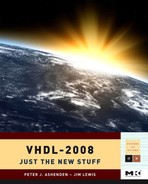VHDL is defined by IEEE Standard 1076, IEEE Standard VHDL Language Reference Manual (the VHDL LRM). The original standard was approved in 1987. IEEE procedures require that standards be periodically reviewed and either reaffirmed or revised. The VHDL standard was revised in 1993, 2000, and 2002. In each revision, new language features were added and some existing features enhanced. The aim in each revision was to improve the language as a tool for design and verification of digital systems.
Since the 2002 revision, there have two parallel efforts to further develop the language. The first was the VHDL Procedural Interface (VHPI) Task Force, a subcommittee of the IEEE P1076 Working Group. The VHPI Task Force prepared an interim amendment to the standard, formally approved by IEEE in March 2007. The amendment is titled IEEE 1076c, Standard VHDI Language Reference Manual—Amendment 1: Procedural Language Application Interface.
In the second effort, during 2004 and 2005, the P1076 Working Group undertook preliminary work toward a new revision of the standard. In June 2005, the board of Accellera approved formation of a Technical Committee (TC) to continue that work, funded jointly by Accellera and TC members directly. The Accellera VHDL-TC worked intensively between September 2005 and June 2006, producing a new draft of the LRM, P1076/D3.0. This draft was a full revision of the VHDL standard, defining numerous new and enhanced language features, incorporating minor clarifications and corrections, and including the VHPI specification from IEEE 1076c. The language defined by this draft is informally called VHDL-2006. The draft was published for trial use by implementers and users during the period from June 2006 to June 2007. Feedback has been rolled into a subsequent draft to be forward to the P1076 Working Group for IEEE standardization. The final version will be informally called VHDL-2008.
The aim of this book is to introduce the new and changed features of VHDL-2008 in a way that is more accessible to users than the formal definition in the LRM. We describe the features, illustrate them with examples, and show how they improve the language as a tool for design and verification. We assume you are already familiar with earlier versions of VHDL, specifically VHDL-2002 and VHDL-93. These versions are described comprehensively in The Designer’s Guide to VHDL, Second Edition, by Peter Ashenden, also published by Morgan Kaufmann Publishers. We hope that the present book will be helpful not only to early adopters of the new language version, but also to tool implementers seeking to understand what it is they have to implement.
In addition to the information presented in this book, additional reference information is available at the authors’ web sites:
We sincerely thank David Bishop of Kodak, Bill Logan of Rockwell Collins, and Chuck Swart of Mentor Graphics for their technical review of various chapters of this book. Their comments led to significant improvement in our explanations and correction of coding errors. Presenting code examples for language features yet to be implemented in tools is a risky business. Having “human compilers” check the code is most valuable. Any remaining errors are, of course, ours.
We would also like to thank Chuck Glaser, our editor at Elsevier, for his encouragement to develop this book. Chuck has a keen sense of what the market needs, and we are happy to take his advice.
Finally, we would like to thank you, the reader, in advance for any comments and corrections. We would love to hear from you, by email at [email protected]. We will maintain a list of errata on the web sites mentioned above.
